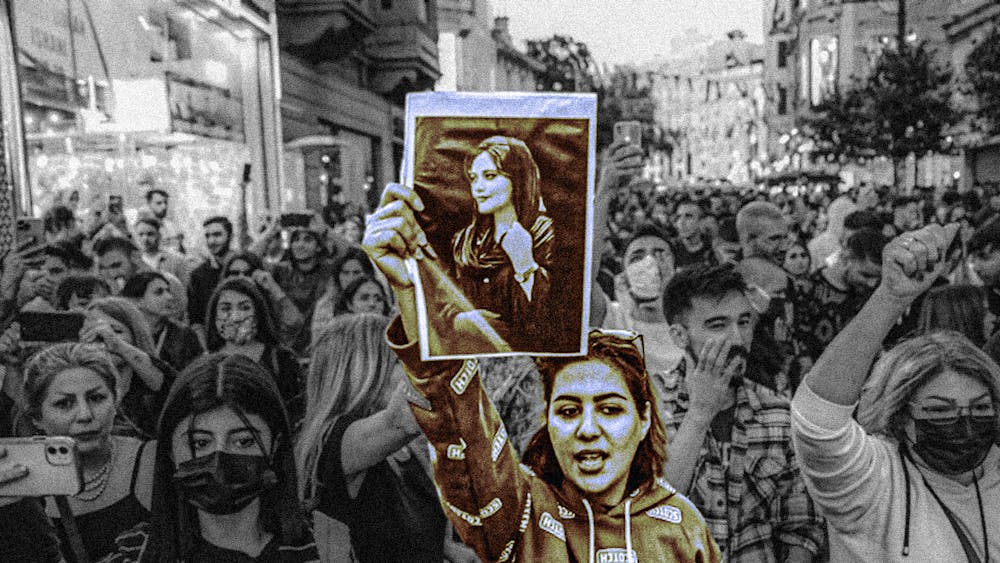The U.S. has had its fair share of popular protest music, like Childish Gambino's “This is America” and Kendrick Lamar’s “Alright,” but songs have always played a key role in social movements across the world by inspiring people to mobilize. As an art form, music has the ability to not only serve as entertainment, but also to build a sense of community through chants, and as rallying calls in protests and demonstrations. Specifically in Iran, music has fueled protests during the recent uprisings as songs refer to the oppressive conditions under the current regime.
The Persian song “Baraye,” by Shervin Hajipour, won a Grammy earlier this year for a new special merit category: Best Song for Social Change. “Baraye” describes the shared struggles and historical challenges that Iranians across the country relate to, making it a quintessential protest song for rallies and congregations across Iran. Iranians have responded to laws that infringe upon their rights and freedoms, many of which limit their freedom of expression, infringe upon due process rights, and undermine the rights of women and children. Iranians can be found chanting the lyrics “for my sister, your sister, our sisters.” “Baraye” has become a symbol for the Iranian protests and demonstrates how music can create worldwide recognition for social movements.
The death of Mahsa Amini under police custody sparked protests across the country and inspired the song “Baraye.” After allegedly wearing the headscarf improperly, Amini was arrested and died only three days after the arrest. While the Iranian government claims that she died from a heart attack, according to many reports, “her death was due to a fracture on her skull due to heavy blows to her head.”
Infuriated by the systematic violence against women under the hands of law enforcement, protests erupted in cities across the world, including in Santiago, Atlanta, Paris, and Tehran where Amini had died. Even students from Penn and the West Philadelphia community held their own demonstration last fall near the Love Statue, mourning the lives of women like Amini. These protests aimed to bring to light the truth about living under an authoritarian regime.
In the past year, the Iranian government has been imposing strict laws that interfere with almost every aspect of Iranian life. The government requires “anyone who explicitly violates any religious taboo in public [to be] imprisoned for up to two months, or flogged with 74 lashes.” More recently, the government has threatened the lives of girls in school and hindered them from receiving an education through gas attacks. Many girls in school have even been hospitalized due to these gas attacks, which have fueled another wave of protests against “bioterrorism.”
As these protests unraveled, songs such as “Baraye'' began to capture people’s feelings of mourning, outrage, and hope for change. Hajipour’s song has even been trending on TikTok with over 18 million views under #Baraye. The song has been featured under posts demonstrating protests and honoring the lives of those who have been killed under the regime. “Baraye” has become a tool for social change in Iran by giving a voice to feelings of frustration, representing the people’s grievances, and amplifying messages of resilience.
Hajipour exclaims in "Baraye," “For the feeling of peace / For the sun after these long nights / For anxiety and sleeping pills / For men, homeland, prosperity / For the girl who wished to be a boy / For women, life, freedom.”
“Baraye” alludes to the peace that Iranians have been desperately fighting for. In his lyrics, Hajipour draws a connection to the chant used by protesters in demonstrations: “Women, Life, Freedom,” where they fight back against discriminatory laws violating basic human rights. Moreover, Hajipour explains how mental illnesses and substance abuse are on the rise due to the fear and anxiety of governmental subjugation. "Baraye" also refers to the solidarity between men and women as they fight side by side against the authoritative regime.
After “Baraye” received over 40 million views in less than two days on Shervin Hajipour’s Instagram, the government responded by arresting the singer on September 29th, 2022. His main charges include “instigating violence” and inciting “propaganda against the regime.” While Hajipour was released on bail shortly after, many others continue to suffer inhumane prison conditions for shedding light upon the regime’s brutal tactics.
“Baraye” has become a national anthem for the Iranian people as they protest the current regime they live under. This song has worked to bring activists together while also emphasizing the oppressive conditions of the country. “Baraye” has become a noteworthy example of how music serves to fuel protests by creating a sense of empowerment and sharing stories that inspire people to continue fighting against injustice.







